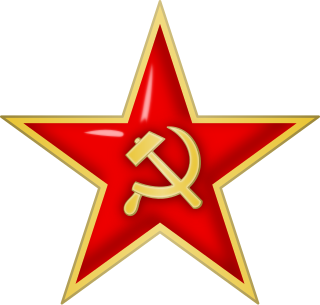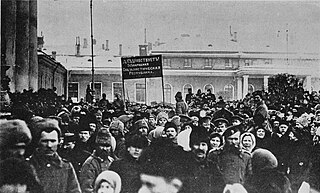
The Workers' and Peasants' Red Army, often shortened to the Red Army, was the army and air force of the Russian Soviet Republic and, from 1922, the Soviet Union. The army was established in January 1918 by Leon Trotsky to oppose the military forces of the new nation's adversaries during the Russian Civil War, especially the various groups collectively known as the White Army. In February 1946, the Red Army was renamed the "Soviet Army" – which in turn became the Russian Army on 7 May 1992, following the dissolution of the Soviet Union.

The Russian Revolution was a period of political and social change in Russia, starting in 1917. This period saw Russia abolish its monarchy and adopt a socialist form of government following two successive revolutions and a civil war. It can also be seen as the precursor for the other revolutions that occurred in the aftermath of World War I, such as the German Revolution of 1918–1919. The Russian Revolution was one of the key events of the 20th century.

The Russian Civil War was a multi-party civil war in the former Russian Empire sparked by the overthrowing of the social-democratic Russian Provisional Government in the October Revolution, as many factions vied to determine Russia's political future. It resulted in the formation of the Russian Socialist Federative Soviet Republic and later the Soviet Union in most of its territory. Its finale marked the end of the Russian Revolution, which was one of the key events of the 20th century.

Pavel Nikolayevich Milyukov was a Russian historian and liberal politician. Milyukov was the founder, leader, and the most prominent member of the Constitutional Democratic party. He changed his view on the monarchy between 1905 and 1917. In the Russian Provisional Government, he served as Foreign Minister, working to prevent Russia's exit from the First World War.
The Green armies, also known as the Green Army or Greens (Зелёные), were armed peasant groups which fought against all governments in the Russian Civil War from 1918 to 1922. The Green armies were semi-organized local militias that opposed the Bolsheviks, Whites, and foreign interventionists, and fought to protect their communities from requisitions or reprisals carried out by third parties. The Green armies were politically and ideologically neutral, but at times associated with the Socialist-Revolutionary Party. The Green armies had at least tacit support throughout much of Russia. However, their primary base, the peasantry, were largely reluctant to wage an active campaign during the Russian Civil War and, with an impending Bolshevik victory, dissolved in 1922.

Pyotr Nikolayevich Krasnov, also known as Peter Krasnov, was a Russian military leader, writer and later Nazi collaborator.
The Kerensky–Krasnov uprising was an attempt by Alexander Kerensky to crush the October Revolution and regain power after the Bolsheviks overthrew his government in Petrograd. It took place between 8 and 13 November 1917 [O.S. 26 and 31 October].

De-Cossackization was the Bolshevik policy of systematic repression against the Cossacks in the former Russian Empire between 1919 and 1933, especially the Don and Kuban Cossacks in Russia, aimed at the elimination of the Cossacks as a distinct collectivity by exterminating the Cossack elite, coercing all other Cossacks into compliance, and eliminating Cossack distinctness. Several scholars have categorised this as a form of genocide, whilst other historians have highly disputed this classification due to the contentious figures which range from "a few thousand to incredible claims of hundreds of thousands".

The State Duma, also known as the Imperial Duma, was the lower house of the legislature in the Russian Empire, while the upper house was the State Council. It held its meetings in the Tauride Palace in Saint Petersburg. It convened four times between 27 April 1906 and the collapse of the empire in February 1917. The first and the second dumas were more democratic and represented a greater number of national types than their successors. The third duma was dominated by gentry, landowners, and businessmen. The fourth duma held five sessions; it existed until 2 March 1917, and was formally dissolved on 6 October 1917.

The Ice March, also called the First Kuban Campaign, a military withdrawal lasting from February to May 1918, was one of the defining moments in the Russian Civil War of 1917 to 1921. Under attack by the Red Army advancing from the north, the forces of the Volunteer Army, sometimes referred to as the White Guard, began a retreat from the city of Rostov south towards the Kuban, in the hope of gaining the support of the Don Cossacks against the Bolshevik government in Moscow.

Joseph Stalin was the General Secretary of the Communist Party of the Soviet Union's Central Committee from 1922 until his death in 1953. In the years following Lenin's death in 1924, he rose to become the leader of the Soviet Union.

The Vyborg Side is a 1939 Soviet drama film directed by Grigori Kozintsev and Leonid Trauberg, the final part of trilogy about the life of a young factory worker, Maxim. The film was also released in the United States under the title New Horizons.

The Volunteer Army (Russian: Добровольческая армия, romanized: Dobrovolcheskaya armiya, abbreviated to Добрармия, Dobrarmiya was a White Army active in South Russia during the Russian Civil War from 1917 to 1920. The Volunteer Army fought against Bolsheviks and the Makhnovists on the Southern Front and the Ukrainian War of Independence. On 8 January 1919, it was made part of the Armed Forces of South Russia, becoming the largest force of the White movement until it was merged with the Army of Wrangel in March 1920.

The Russian Provisional Government was a provisional government of the Russian Empire and Russian Republic, announced two days before and established immediately after the abdication of Nicholas II on 2 March, O.S. [15 March 1917, N.S.], during the February Revolution. The intention of the provisional government was the organization of elections to the Russian Constituent Assembly and its convention. The provisional government, led first by Prince Georgy Lvov and then by Alexander Kerensky, lasted approximately eight months, and ceased to exist when the Bolsheviks gained power in the October Revolution in October [November, N.S.] 1917.

The April Crisis, which occurred in Russia throughout April 1917, broke out in response to a series of political and public controversies. Conflict over Russia's foreign policy goals tested the dual power arrangement between the Petrograd Soviet and the Russian Provisional Government. The Executive Committee and the full Soviet endorsed Nikolai Sukhanov's "An Appeal to All the Peoples of the World", which renounced war and "acquisitionist ambitions." This appeal conflicted with the Provisional Government's position on annexations, and Foreign Minister Pavel Milyukov responded with the Milyukov note on 18 April declaring Russia's right to Constantinople and the Dardanelles.

The Battle of Tsaritsyn was a military confrontation between the Red Army and the White Army during the Russian Civil War for control of Tsaritsyn, a significant city and port on the Volga River in southwestern Russia.

The February Revolution, known in Soviet historiography as the February Bourgeois Democratic Revolution and sometimes as the March Revolution or February Coup was the first of two revolutions which took place in Russia in 1917.

During the Russian Civil War of 1917-1923, a number of former Tsarist officers joined the Red Army, either voluntarily or as a result of coercion. This list includes officers of the Imperial Russian Army commissioned before 1917 who joined the Bolsheviks as commanders or as military specialists. For former Tsarist NCOs promoted under the Soviets, see Mustang.

Anatoli Grigorievich Zhelezniakov (1895–1919) was a Russian anarchist and revolutionary best known for dispersing the short-lived Russian Constituent Assembly on Bolshevik orders during the October Revolution.

Konstantin Aleksandrovich Mekhonoshin was a Russian Bolshevik revolutionary, Soviet military figure and politician.


















